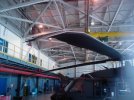They do make a slight difference in sound. You can usually tell the difference between an A/L and an M out on the flight line. The difference is not as dramatic as on the video/link.Army UH-60M is out with them on the new wide cord blades to increase lift, nothing to do with "sound".
Oh, and YES, the M has a rotor brake. After flying the Seahawk, that is one the thing I think I missed the most when I started flying the Blackhawk.
Here is a bad cell phone shot of the wide chord blade on the M model.


